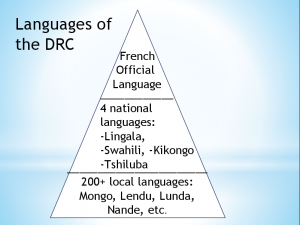The following was taken from the literature review I wrote in the fall of 2016:
“The definition of acculturation is contested (Faragallah et al. 2007), but according to one of the first studies of acculturation by Redfield, Linton, and Herskovits (1936), acculturation is the culture change which results from continuous, first hand contact between two distinct cultural groups. Acculturation can be measured through changes in lifestyle dimensions, such as language, daily habits, living arrangements, ethnic norms, social relationships, political affiliation, and religious affiliations (Lam 1995). Language is critical, as acculturation is often measured through language proficiency and/or brokering, e.g., translating and interpreting (Lazarevic et al 2014; Suárez-Orozco and Suárez-Orozco 2001, 2008).
It is important to measure acculturation because according to Hall (2007), those with higher levels of acculturation saw additional economic gains. Conversely, negative consequences may occur from acculturative stress, or the reduction in the health status by individuals undergoing acculturation (Berry et al. 1987). People who were forced to flee from their homes, or refugees, have a higher mean level of acculturative stress in comparison to voluntary immigrants (Berry et al. 1987). Having communities of one’s own ethnic background may help to shorten the adjustment period, provide protection against hostility and rejection, and maintain cultural traditions (Nann 1983).
According to Berry (1990, 2003), individuals adopt different acculturation strategies, which include the following: the separate strategy, in which the individual maintains strong positive ties with the culture of origin and does not associate with the new culture; assimilation, in which the individual rejects the culture of origin and embraces the new culture; marginalization, in which the individual does not relate to either the culture of origin or the new culture; and integration, in which the individual relates well to both the culture of origin and the new culture. By defining which acculturation strategy(ies) the Congolese community has embraced, the original community can better meet their needs and work towards their integration into the community, in order to prevent secondary migration (Weine et al. 2011).”
Throughout this research project, it’s important to continue adding sources and to continue learning about other definitions of things that we are exploring. In my Human Macroecology class, I stumbled across a piece of writing that again changed my view of acculturation in anthropologist Steward’s “Theory of culture change; the methodology of multilinear evolution” (1972). He posits that the taxonomy traditionally used in anthropology and ethnology (when studying tribal culture) should and cannot be used to study nation states (51). In other words, instead of classifying only very specialized traits of the entire culture, Stewart transits that in the assimilation of any ethnic minority, first certain traits have been adopted from a particular subcultural group with which the minority had contact with first, followed by specific national traits (46).
This is helpful in understanding our research subjects’ positions. In the past, to measure acculturation, I had tried to measure national variables, like the subject’s political affiliation or feelings towards the United States. But national variables are simply too vast for any one individual to contain. Therefore, in measuring the acculturation of someone in their 20s, perhaps we should measure how closely they are integrating into their corresponding group, like a group of college students. In measuring the acculturation of an adult, perhaps a better measure of their acculturation would be their children’s involvement in school activities or their number of non-Congolese friends.
Sources:
Berry, John W., Uichol Kim, Thomas Minde, and Doris Mok. 1987. “Comparative Studies of Acculturative Stress.” The International Migration Review 21(3):491-511.
Hall, Matthew. 2013. “Moving On and Moving Up: Interstate Migration in the Process of Immigrant Assimilation.” Paper presented at the annual meeting of the American Sociological Association, New York, NY.
Faragallah, Mona H., Walter R. Schumm, and Farrell J. Webb. 1997. “Acculturation of Arab-American Immigrants: an Exploratory Study.” Family Studies 28(3):182-203.
Lam, Tony. 1995. “A Review of Conceptualization and Measurement of Acculturation.” Multicultural Education 2:129-43.
Lazarevic, Vanja, Marcela Raffaelli, and Angela Wiley. 2014. “Language and Non-linguistic Brokering: Diversity of Experiences of Immigrant Young Adults from Eastern Europe.” Journal of Comparative Family Studies 45(4): 517-535.
Nann, Richard C. 1983. Uprooting and Surviving: Adaptation and Resettlement of Migrant Families and Children. Holland: D Reidel Publishing Company.
Redfield, Robert, Ralph Linton, and Melville J. Herskovits. 1936. “Memorandum for the Study of Acculturation.” American Anthropologist 38(1):149-52.
Steward, Julian Haynes. 1972. Theory of culture change; the methodology of multilinear evolution. Urbana: University of Illinois Press.
Suárez-Orozco, C. and M. Suárez-Orozco. 2001. Children of Immigration. Cambridge, MA: Harvard University Press.
Suárez-Orozco, C., M. Suárez-Orozco and T. Todorova. 2008. Learning a New Land: Immigrant Children in American Society. Cambridge, MA: Harvard University Press.
Weine, Stevan Merrill, Yael Hoffman, Norma Ware, Toni Tugenberg, Leonce Hakizimana, Gonwo Dahnweigh, Madeleine Currie, and Maureen Wagner. 2011. “Secondary Migration and Relocation Among African Refugee Families in the United States.” Family Process 50(1):27-46.

